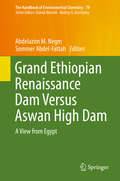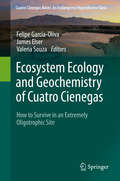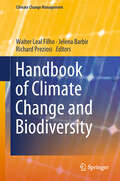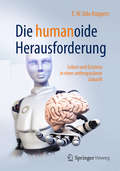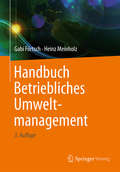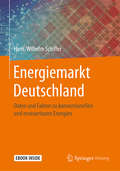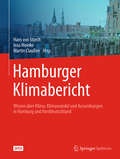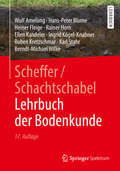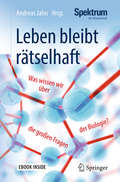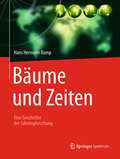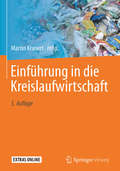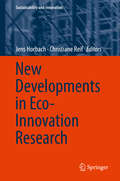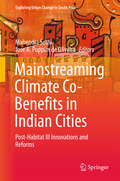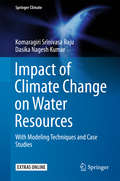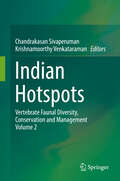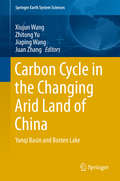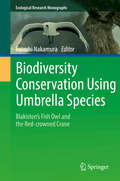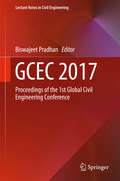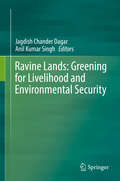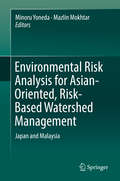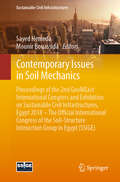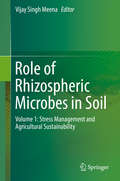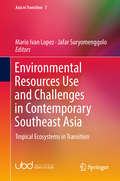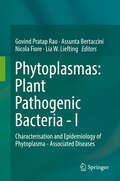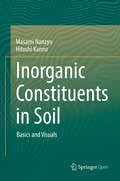- Table View
- List View
Grand Ethiopian Renaissance Dam Versus Aswan High Dam: A View from Egypt (The Handbook of Environmental Chemistry #79)
by Abdelazim M. Negm Sommer Abdel-FattahThis unique volume discusses various aspects of the Grand Ethiopian Renaissance Dam (GERD) and the Aswan High Dam (AHD) including their positive and negative impacts. It presents up-to-date research findings by Egyptian scientists and researchers covering several interesting hot topics under the following main themes: · Major impacts of GERD compared with the AHD · Environmental impacts of the AHD · Modeling scenarios investigating the impacts of GERD on the AHD and downstream · Environmental and social impacts of GERD on Egypt · Status and assessment of the sediment of the AHD reservoir and modeling the impacts of GERD on Lake Nubia sediment accumulation · Proposed scenarios for maximizing the benefits of the AHD reservoir · International aspects of GERD and the AHD The volume also offers a set of conclusions and recommendations to optimize the cooperation between Egypt, Sudan, and Ethiopia. It appeals to postgraduate students, researchers, scientists, professionals and policy planners.
Ecosystem Ecology and Geochemistry of Cuatro Cienegas: How To Survive In An Extremely Oligotrophic Site (Cuatro Ciénegas Basin: An Endangered Hyperdiverse Oasis Ser.)
by Valeria Souza James Elser Felipe García-OlivaCarbon (C), Nitrogen (N) and Phosphorus (P) are three of the most important elements used to build living beings, and their uptake from the environment is consequently essential for all organisms. Photosynthesis is the process in which plants absorb atmospheric C as they grow and convert it to biomass. However, plants acquire N and P only when these are available in the soil solution, which makes these elements the most limiting nutrients in plant growth and productivity in most ecosystems. When plant residues and roots decompose, the C, N and P they contain is transformed primarily into soil organic matter (SOM) or C and N can release to the atmosphere. Recent interest on the global C, N and P cycles has focused attention on the different proportion of terrestrial C, N and P stored in different ecosystem pools. Cuatro Cienegas represents an exceptional place, since the plants are not the base of the food web, they are the microbial community, that recycle the elements essential for life. In this book we describe how this is an analog of early Earth.
Handbook of Climate Change and Biodiversity (Climate Change Management Ser.)
by Richard Preziosi Jelena Barbir Walter Leal FilhoThis book comprehensively describes essential research and projects on climate change and biodiversity. Moreover, it includes contributions on how to promote the climate agenda and biodiversity conservation at the local level. Climate change as a whole and global warming in particular are known to have a negative impact on biodiversity in three main ways. Firstly, increases in temperatures are detrimental to a number of organisms, especially those in sensitive habitats such as coral reefs and rainforests. Secondly, the pressures posed by a changing climate may lead to sets of responses in areas as varied as phenology, range and physiology of living organisms, often leading to changes in their lifecycles (especially but not only in reproduction), losses in productivity or even death. In some cases, the very survival of very sensitive species may be endangered. Thirdly, the impacts of climate change on biodiversity will be felt in the short term with regard to some species and ecosystems, but also in the medium and long term in many biomes. Indeed, if left unchecked, some of these impacts may be irreversible. Many individual governments, financial institutes and international donors are currently spending billions of dollars on projects addressing climate change and biodiversity, but with little coordination. Quite often, the emphasis is on adaptation efforts, with little emphasis on the connections between physio-ecological changes and the lifecycles and metabolisms of fauna and flora, or the influence of poor governance on biodiversity. As such, there is a recognized need to not only better understand the impacts of climate change on biodiversity, but to also identify, test and implement measures aimed at managing the many risks that climate change poses to fauna, flora and micro-organisms. In particular, the question of how to restore and protect ecosystems from the impact of climate change also has to be urgently addressed. This book was written to address this need. The respective papers explore matters related to the use of an ecosystem-based approach to increase local adaptation capacity, consider the significance of a protected areas network in preserving biodiversity in a changing northern European climate, and assess the impacts of climate change on specific species, including wild terrestrial animals. The book also presents a variety of case studies such as the Yellowstone to Yukon Conservation Initiative, the effects of climate change on the biodiversity of Aleppo pine forest in Senalba (Algeria), climate change and biodiversity response in the Niger Delta region, and the effects of forest fires on the biodiversity and the soil characteristics of tropical peatlands in Indonesia. This is a truly interdisciplinary publication, and will benefit all scholars, social movements, practitioners and members of governmental agencies engaged in research and/or executing projects on climate change and biodiversity around the world.
Die humanoide Herausforderung: Leben und Existenz in einer anthropozänen Zukunft
by E.W. Udo KüppersCui bono? – Wem nutzt die Entwicklung humanoider Maschinen oder Automaten? Dieses Buch erörtert die Details dieses Spannungsfelds und die Herausforderung gesellschaftlicher Weiterentwicklung. Als technisch-elektronische Handhabungsgeräte können sie den Menschen zuträglich sein, sie von körperlich belastenden Arbeiten oder sogenannten Routinearbeiten befreien. Der Autor versucht die Fragen zu beleuchten: Was erwartet die Menschheit durch die Entwicklung einer künstlichen Intelligenz in einer menschähnlichen Maschine? Was aber, wenn der selbstbestimmende Mensch an der Schwelle steht, sich selbst durch intelligente selbstorganisierte Produkte und Prozesse eine humanoide Konkurrenz zu schaffen, die er möglicherweise nicht mehr kontrollieren kann?
Handbuch Betriebliches Umweltmanagement
by Heinz Meinholz Gabi FörtschIn kompakter Form stellt dieses Handbuch das notwendige Wissen für das betriebliche, nachhaltige Umweltmanagement zur Verfügung. Es ist als Nachschlagewerk zur Einführung und Fortschreibung eines Umweltmanagementsystems konzipiert. Darüber hinaus kann es als Lehrbuch bzgl. der Grundaspekte des betrieblichen Umweltmanagements verwendet werden.
Energiemarkt Deutschland: Daten und Fakten zu konventionellen und erneuerbaren Energien
by Hans-Wilhelm SchifferEnergiewirtschaftliche Entscheidungen und technische Weichenstellungen erfordern eine fundierte Datenbasis. Die wichtigsten Zahlen und Fakten zu deutschen und europäischen Energiemärkten (Mineralöl, Braunkohle, Steinkohle, Erdgas und Elektrizität), zu den Eigentumsverhältnisse von über 100 Energieunternehmen und Nachfrage- sowie Angebotsstrukturen sind in diesem Buch vermittelt. Es bietet sich als Nachschlagewerk und Einführung in die vielfältige Thematik an. Über 100 Tabellen und mehr als 200 Diagramme erleichtern den Zugang zu den umfangreichen Daten. Ein Glossar hilft dabei, Klarheit in die unterschiedlichen Begrifflichkeiten zu bekommen. Berater, Entscheider und an Kennzahlen interessierte Leser finden in diesem Buch umfangreiches Material für die eigene fachliche Fragestellung. Der Autor ist Executive Chair of the World Energy Resources Programme des World Energy Council, London. Er war viele Jahre in zwei Bundesministerien sowie in leitender Funktion bei einem großen Energieunternehmen tätig und ist Lehrbeauftragter in verschiedenen Masterstudiengängen an der RWTH Aachen.Aus dem Inhalt- Grundlagen der Energiewirtschaft- Struktur einzelner Energie-Teilmärkte- Erneuerbare Energien- Preisbildung in der Energiewirtschaft- Entwicklung der Energienachfrage- Klimaschutz und Emissionshandel- Perspektiven der Energieversorgung- Energiepolitik (Bundesebene)
Hamburger Klimabericht – Wissen über Klima, Klimawandel und Auswirkungen in Hamburg und Norddeutschland
by Martin Claußen Insa Meinke Hans Von StorchBereits zum zweiten Mal wird im Rahmen des KlimaCampus Hamburg der aktuelle Forschungsstand zum Klimawandel in der Hamburger Metropolregion und Norddeutschland systematisch dokumentiert. Erfahren sie auf Basis der Fachliteratur in welchem Maße Konsens hinsichtlich des Klimawandels in Norddeutschland besteht.Inwieweit sind Entwicklungen bereits messbar, welche Auswirkungen zeigen sich bereits heute und wie kann sich die Region vor negativen Folgen des Klimawandels schützen? Die über 70 Autoren haben die Forschungsergebnisse zu diesen Fragen systematisch zusammengetragen. Die Übereinstimmung bzw. Widersprüchlichkeit des derzeitigen Wissens wurde dabei herausgearbeitet, Erkenntnisgewinne gegenüber dem ersten Hamburger Klimabericht lokalisiert und weiterhin bestehender Forschungsbedarf aufgezeigt. Alle Beiträge wurden einem wissenschaftlichen Begutachtungsprozess unterzogen, der von einem Lenkungsausschuss überwacht wurde.Die Dokumentation belegt umfassend eine bereits stattfindende Erwärmung in der Metropolregion Hamburg und in Norddeutschland, sowie einen Meeresspiegelanstieg an Nord- und Ostsee. Mit der Erwärmung zeichnen sich deutliche Änderung im Ökosystem ab. Diese bereits eingetretenen Entwicklungen können sich künftig weiter verstärken. Erfahren Sie, welche Auswirkungen dies für Politik, Wirtschaft und Gesellschaft hat.Dieses Buch ist eine Open-Acess-Publikation unter einer CC BY-NC 4.0 Lizenz
Scheffer/Schachtschabel Lehrbuch der Bodenkunde: Lehrbuch Der Bodenkunde
by Berndt-Michael Wilke Karl Stahr Ruben Kretzschmar Ingrid Kögel-Knabner Ellen Kandeler Rainer Horn Heiner Fleige Hans-Peter Blume Wulf AmelungDie 17. Auflage dieses renommierten Lehrbuches vermittelt ein umfassendes Wissen über Böden und deren Schutz. Böden bilden eine der wichtigsten Grundlagen für das terrestrische Leben. Für einen effektiven Schutz und Erhalt dieses Lebensraums braucht es ein grundlegendes Verständnis der Prozesse, die Böden formen, sowie der Eigenschaften der Böden selbst. Dieses Buch fasst den neusten Kenntnisstand der Forschung zusammen und vermittelt ein umfassendes Wissen der Bodenkunde. Im Detail werden behandelt: die Vorgänge der Bodenbildung und -entwicklung,die physikalischen, chemischen und biologischen Eigenschaften und Prozesse, Nähr- und Schadstoffe,die verschiedenen Bodensystematiken, die wichtigsten Böden und Bodenlandschaften,die Nutzungsbewertung der Böden, Grundsätze des Bodenschutzes. Die 17. Auflage wurde überarbeitet und ergänzt. Neu ist ein Kapitel zu Nanopartikeln als Schadstoffe im Boden. Durch seine Ausführlichkeit ist dieses Buch ein Must-Have für alle, die sich mit Böden befassen.
Leben bleibt rätselhaft: Was wissen wir über die großen Fragen der Biologie?
by Andreas JahnDie ungeklärten Mysterien der BiologieWoher kommt das Leben? Warum schlafen wir? Wie können wir länger leben? Drei von sechs grundlegenden Fragen, die immer noch weitgehend offen sind und mit denen sich die moderne Biologie beschäftigt. Zu den ungelösten Mysterien zählen außerdem Evolution, Vererbung und Bewusstsein. Wie namhafte Wissenschaftler aus aller Welt versuchen, der Natur diese Geheimnisse Stück für Stück zu entlocken, beschreibt dieses Buch anhand ausgewählter Artikel aus den Zeitschriften "Spektrum der Wissenschaft" und "Gehirn&Geist". Meist sind es die Forscher selbst, die aus erster Hand ihre Beobachtungen und Entdeckungen schildern und somit Gelegenheit geben, ihnen über die Schulter zu schauen. Dabei sind sie sich längst nicht in allen Punkten einig. Der vorliegende Sammelband spiegelt den aktuellen Wissensstand, aber auch die zum Teil kontroversen Ansichten über die Wunder des Lebens wider.
Bäume und Zeiten – Eine Geschichte der Jahrringforschung
by Hans Hermann RumpAnhand der Jahresringe von Bäumen können kultur- und naturhistorische Ereignisse datiert und eingeordnet werden. Wie diese Methode entwickelt wurde und wie sie noch heute eingesetzt wird, beschreibt dieses Buch eindrucksvoll. Es bietet einen Einblick in Konzepte und Arbeitsmethoden von Naturforschern bei ihrer Suche nach verlässlichen Chronologien von der frühen Neuzeit bis heute. Fehler und methodische Irrwege als systembedingte Begleiter langwieriger und komplexer Forschungsprozesse blieben dabei nicht aus. Deshalb wird die Dynamik des „Gewordenen“ und nicht die Statik des „Gewesenen“ in den Mittelpunkt der Betrachtung gestellt. Die thematisch breit gefächerte und interdisziplinär konzipierte Darstellung spricht nicht nur Vertreter der Life Sciences und der historischen Wissenschaften an. Auch für einen weiteren Leserkreis ist die Entwicklung einer Forschungsmethode von Interesse, die im aktuellen Diskurs um die Veränderung des globalen Klimas eine wichtige Rolle spielt.
Einführung in die Kreislaufwirtschaft: Planung -- Recht -- Verfahren
by Martin KranertDie f#65533;nfte Auflage dieses Buches liefert einen #65533;berblick #65533;ber den neuesten Stand zu Ressourcen- und Klimaschutz durch Kreislaufwirtschaft und zur Verwertung von Altprodukten und Altstoffen (inkl. Papier, LVP, Glas, Metall, RDF, Elektronikschrott und seltene Metalle). Schredder und Zerkleinerungstechnik werden im Kapitel Aufbereitung fester Abfallstoffe besprochen. Am Ende eines jeden Kapitels befinden sich zahlreiche Kontroll- und #65533;bungsaufgaben. Enthalten sind weiterhin aktuelle Entwicklungen, unter anderem aus der Abfallwirtschaftlichen Planung, des Umweltmanagements und der betrieblichen Abfallwirtschaft. Ein umfassendes Glossar mit Erl#65533;uterungen zu den Fachbegriffen sowie erg#65533;nzende Tabellen runden dieses Buch ab. Unter Mitwirkung von kompetenten Fachleuten und Experten, die in Lehre und Forschung auf dem Gebiet der Abfallwirtschaft t#65533;tig sind, wurde die 5. Auflage den aktuellen Entwicklungen angepasst.
New Developments in Eco-Innovation Research (Sustainability and Innovation)
by Jens Horbach Christiane ReifEco-innovations are crucial for reducing the environmental damages arising from economic activities, and are one of the main drivers of a successful transition towards sustainable development and remedying essential climate change problems. This book provides an overview of recent advances in the rapidly growing field of eco-innovation research, adopts an interdisciplinary perspective and outlines the main future developmental trends. A broad range of topics are addressed, including a bibliometric analysis of eco-innovation research, the relationship between eco-innovation and corporate sustainability, eco-innovation system analysis, new evidence on the economic effects of eco-innovation, and the relevance of policy and policy mixes for eco-innovation activities. The book is dedicated to Klaus Rennings, one of the most important representatives of this field, who unexpectedly passed away in September 2015.
Mainstreaming Climate Co-Benefits in Indian Cities: Post-Habitat III Innovations and Reforms (Exploring Urban Change in South Asia)
by Jose A. Puppim de Oliveira Mahendra SethiThis volume presents a novel framework to understand urban climate co-benefits in India, that is, tackling climate change and achieving sustainable development goals in cities. It utilizes methods and tools from several assessment frameworks to scientifically evaluate sector co-benefits for informed decision making. The co-benefits approach can lead to significant improvements in the way societies use environmental resources and distribute their outputs. The volume discusses four main themes: (1) Concepts and theories on cities and climate co-benefits; (2) Contextualizing co-benefit issues across spatial scales and sectors; (3) Sectoral analyses of co-benefits in energy, transport, buildings, waste, and biodiversity, and (4) Innovations and reforms needed to promote co-benefits in cities. The discussions are based on empirical research conducted in Indian cities and aligned with the international discourse on the 2030 UN Development Agenda and New Urban Agenda created at the UN-Habitat III in 2016. The analyses and recommendations in this volume are of considerable interest to policy experts, scholars and researchers of urban and regional studies, geography, public policy, international development/law, economics, development planning, environmental planning, climate change, energy studies, and so on.
Impact of Climate Change on Water Resources: With Modeling Techniques and Case Studies (Springer Climate)
by Dasika Nagesh Kumar Komaragiri Srinivasa RajuThis book gives an overview of various aspects of climate change by integrating global climate models, downscaling approaches, and hydrological models. It also covers themes that help in understanding climate change in a holistic manner. The book includes worked-out examples, revision questions, exercise problems, and case studies, making it relevant for use as a textbook in graduate courses and professional development programs. The book will serve well researchers, students, as well as professionals working in the area of hydroclimatology.
Indian Hotspots: Vertebrate Faunal Diversity, Conservation And Management Volume 2
by Krishnamoorthy Venkataraman Chandrakasan SivaperumanThis book offers a comprehensive account of India’s four biodiversity hotspots: the Himalaya, Indo-Burma, Western Ghats and Sri Lanka and Andaman and Nicobar Islands. With a focus on tropical rainforests, it includes more than 30 chapters covering different vertebrate fauna e.g. fishes, amphibians, reptiles, birds, and mammals, as well as topics such as conservation and management aspects.Written by experts in the field of biodiversity conservation and management, it offers ample new insights into a number of subjects related to the faunal communities of tropical forest ecosystems, providing a valuable resource for conservationists and researchers in the field of flora and fauna diversity.
Carbon Cycle in the Changing Arid Land of China: Yanqi Basin And Bosten Lake (Springer Earth System Sciences Ser.)
by Juan Zhang Jiaping Wang Zhitong Yu Xiujun WangThis book integrates the analyses of organic carbon and carbonate accumulation in soil and lake sediment in a typical arid region of China that has experienced significant climate and land-use changes.It demonstrates that carbonate accumulation greatly exceeds organic carbon in both soil and sediment. It also shows that intensive cropping with sound land management in the arid land not only increases soil organic carbon stock, but also enhances accumulation of soil carbonate, particularly in subsoils. Carbon accumulation in the lake sediment increased between 1950 and 2000, after which it declined, and the authors explore how human activity and climate change may have caused the changes in carbon burial in the lake sediment.This book is of interest to researchers in a number of fields such as soil science, limnology and global change, as well as to the policy-makers.
Biodiversity Conservation Using Umbrella Species: Blakiston's Fish Owl And The Red-crowned Crane (Ecological Research Monographs)
by Futoshi NakamuraThis book focuses on Blakiston’s fish owl and the red-crowned crane as umbrella species. Healthy river, riparian and wetland ecosystems are necessary to maintain the populations of the two species. Both species have been revered by people since ancient times, but both are currently listed as endangered because of their small population sizes. The population decline of the two species can be mainly attributed to the degradation of the natural riparian and wetland habitats, which is associated with land use development.The populations of the two species are now recovering in Japan due to recent conservation and reproduction efforts, but the genetic diversity of the two species are still low due to previous bottleneck effects. To develop conservation and dispersal plans to establish the species over the East Asian mainland and on the island of Hokkaido, basic information, such as their regional distribution, genetic diversity, food availability, reproductive traits, and nesting, breeding, rearing, and commuting habitat, is essential. The intensive, collaborative studies conducted in Japan and Russia has clarified the status quo and the ecology of the two species. This is the first book that comprehensively compiles the above information for the mainland and island populations. In addition, it verifies their suitability as umbrella species of an ecosystem and the possibility of their future population expansion, taking into account changes in land use in Hokkaido, which is about to experience a dramatic decline in human population. As such, the book provides valuable information for students who wish to learn about these beautiful symbolic creatures, for NGOs engaged in conservation activities, and for managers who are involved in creating conservation plans and implementing restoration projects.
Gcec 2017: Proceedings Of The 1st Global Civil Engineering Conference (Lecture Notes in Civil Engineering #9)
by Biswajeet PradhanThis book gathers the proceedings of the 1st Global Civil Engineering Conference, GCEC 2017, held in Kuala Lumpur, Malaysia, on July 25–28, 2017. It highlights how state-of-the-art techniques and tools in various disciplines of Civil Engineering are being applied to solve real-world problems. The book presents interdisciplinary research, experimental and/or theoretical studies yielding new insights that will advance civil engineering methods. The scope of the book spans the following areas: Structural, Water Resources, Geotechnical, Construction, Transportation Engineering and Geospatial Engineering applications.
Ravine Lands: Greening for Livelihood and Environmental Security
by Anil Kumar Singh Jagdish Chander DagarThis book, the only one of its kind on ravine lands, reflects the significant advances made over the past two decades in our understanding of gully erosion, its controlling factors, and various aspects of gully erosion. It also addresses central research gaps and unanswered questions, which include historical studies on gully erosion to better understand the different stages of their formation; appropriate measuring techniques for monitoring or assessing the geological and hydrological parameters and processes involved in gully development; interaction of hydrological and other soil degradation processes; ecology and biodiversity of fragile ravines; impact of climate and environmental changes on soil erosion processes; development of effective and reliable gully erosion models; effective gully prevention and control measures; watershed-based management options; and ravine rehabilitation policies. The present book is a highly timely publication and deals with various aspects of ravine ecology and rehabilitation of degraded lands, particularly with the aid of biological approaches. As such, it offers a valuable guide for all scientists working in the fields of soil conservation / rehabilitation and agroforestry, students, environmentalists, educationists, and policymakers. More importantly, it focuses on the rehabilitation of one of the world’s most degraded and fragile ecosystems, ensuring the livelihoods of resource-poor farmers and landless families living in harsh ecologies that are more vulnerable to climate change.
Environmental Risk Analysis for Asian-Oriented, Risk-Based Watershed Management: Japan And Malaysia
by Mazlin Mokhtar Minoru YonedaThis publication is a practical guidebook on environmental risk assessment, especially for watershed-scale management. It highlights case studies of watershed environmental risk in Malaysia, including the potential health risks as well as screening methods and management in practice. In order to apply environmental risk assessment methods for the management of toxic chemicals, it is necessary to consider the geological and climate features of each country as well as their cultural characteristics. Focusing on Malaysia as a representative country, the book also discusses studies in other Asian countries. The insights provided can be applied to advanced and developing countries alike. A suitable textbook for graduate students, it is also a valuable reference source for researchers, practitioners and policymakers.
Contemporary Issues in Soil Mechanics: Proceedings of the 2nd GeoMEast International Congress and Exhibition on Sustainable Civil Infrastructures, Egypt 2018 – The Official International Congress of the Soil-Structure Interaction Group in Egypt (SSIGE) (Sustainable Civil Infrastructures)
by Sayed Hemeda Mounir BouassidaThis volume is of interest to practical engineers. It discusses some contemporary issues related to soil mechanics in earthwork projects which are critical components in civil construction and often require detailed management techniques and unique solution methods to address failures. Being earth bound, earthwork is influenced by geomaterial properties at the onset of a project. Hence, an understanding of the in-situ soil properties is essential. Slope stability is a common problem facing earthwork construction, such as excavations and shored structures. Analytical methods for slope stability remain critical for researchers due to the mechanical complexity of the system. Striving for better earthwork project managements, the geotechnical engineering community continues to find improved testing techniques for determining sensitive properties of soil and rock, including stress-wave based, non-destructive testing methods. To minimize failure during earthwork construction, past case studies and data may reveal useful lessons and information to improve project management and minimize economic losses. This volume discusses these aspects using appropriate methods in a simple way. The volume is based on the best contributions to the 2nd GeoMEast International Congress and Exhibition on Sustainable Civil Infrastructures, Egypt 2018 – The official international congress of the Soil-Structure Interaction Group in Egypt (SSIGE).
Role of Rhizospheric Microbes in Soil: Volume 2: Nutrient Management And Crop Improvement
by Vijay Singh MeenaIn any ecosystem, plant and microbe interaction is inevitable. They not only co-exist but also support each other’s survival and provide sustenance in stressful environments. Agro-ecosystems in many regions around the globe are affected by high temperatures, soil salinity/alkalinity, low pH and metal toxicity. High salinity and severe draught are other major constraints affecting agricultural practices and also plants in the wild. A major limiting factor affecting global agricultural productivity is environmental stresses. Apart from decreasing yield, they also have a devastating impact on plant growth. Plants battle with various kind of stresses with the help of symbiotic associations with the rhizospheric microbes. Naturally occuring plant-microbe interactions facilitate the survival of plants under these stressful conditions.The rhizosphere consists of several groups of microbes, plant growth-promoting bacteria (PGPB) is one such group of microbes that assists plants in coping with multiple stresses and also promote plant growth. These efficient microbes support the stress physiology of the plants and can be extremely useful in solving agricultural as well food- security problems.This book provides a detailed, holistic description of plant and microbe interaction. It elucidates various mechanisms of nutrient management, stress tolerance and enhanced crop productivity in the rhizosphere, discussing The rhizospheric flora and its importance in enhancement of plant growth, nutrient content, yield of various crops and vegetables as well as soil fertility and health. Divided into two volumes, the book addresses fundamentals, applications as well as research trends and new prospects for agricultural sustainability. Volume 1: Stress Management and Agricultural Sustainability, includes chapters offering a broad overview of plant stress management with the help of microbes. It also highlights the contribution of enzymatic and molecular events occurring in the rhizosphere due to plant microbe interactions, which in turn help in the biological control of plant disease and pest attacks. Various examples of plant microbe interaction in rhizospheric soil are elaborated to facilitate the development of efficient indigenous microbial consortia to enhance food and nutritional security. Providing a comprehensive information source on microbes and their role in agricultural and soil sustainability, this timely research book is of particular interest to students, academics and researchers working in the fields of microbiology, soil microbiology, biotechnology, agronomy, and the plant protection sciences, as well as for policy makers in the area of food security and sustainable agriculture.
Environmental Resources Use and Challenges in Contemporary Southeast Asia: Tropical Ecosystems In Transition (Asia in Transition #7)
by Jafar Suryomenggolo Mario Ivan LopezThis edited volume introduces dynamic approaches to the study of Southeast Asia’s environmental diversity from different disciplinary perspectives at the interface between the natural and social sciences. It brings together research on the region’s environmental resource use and shared ecological challenges in the context of present day globalization to offer insights for possible future directions. The book introduces unique approaches to the study of Southeast Asia’s environmental changes and resource management under the influence of intensifying economic change in the region. It also examines the slow erosion of Southeast Asia’s rich environment and addresses serious issues such as the decrease in biodiversity and tropical forests, and the degradation of peat lands. At the same time, it discusses the social issues that are tied to energy-dependent growth and have intensified over the last two decades. It also analyzes the new roadmaps being created to protect, conserve, and manage the environment. By investigating the many ecological issues surrounding us, the volume brings to light the constant struggles we face while trying to develop a more inclusive and equitable approach to natural resources governance. This volume is relevant for students, academics and researchers who have an interest in the Southeast Asian environment and the way in which we use and interact with it.
Phytoplasmas: Characterisation And Epidemiology Of Phytoplasma - Associated Diseases
by Lia W. Liefting Nicola Fiore Assunta Bertaccini Govind Pratap RaoPhytoplasma-associated diseases are a major limiting factor to quality and productivity of many ornamentals, horticultural and other economically important agriculture crops worldwide. Annual losses due to phytoplasma diseases in many crops vary, but under the pathogen favorable conditions they always lead to disastrous consequences to farming community. As there is no effective cure for phytoplasma diseases, the management options emphasize on their exclusion, minimizing their spread by insect vectors and propagation materials and on development of host plant resistance. The phytoplasma associated plant diseases have a history of more than 50 years. Phytoplasmas have undoubtedly infected plants and cause diseases for centuries before they are described and proven to be the causal agents. But important progress related to identification of phytoplasmas only began after 1980’s. Phytoplasmas have emerged as the most serious constraints in the production of several crops all around the world during last four decades. Phytoplasmas constitute a major limiting factor to quality and productivity of cereals, horticultural, ornamentals and many other economically important crops all over the world. Annual losses due to phytoplasma diseases may vary, but under the pathogen favorable condition, phytoplasma disease may lead to disastrous consequences for farming and industry community. The scientific literature concerning phytoplasma occurrence, characterization, diagnosis, detection, and management is growing at a fast pace. Significant advancement in the last decades on diagnostic, biological and molecular properties, epidemiology, host-pathogen-insect interactions as well as management of phytoplasmas has been made. Till date, no authentic compilation is available to know the progress of phytoplasmas characterization major crops all over the world. The planned book will compile all the updated information available information on phytoplasmas by distinguished experts in the form of edited book entitled “Characterization and epidemiology of phytoplasma associated diseases”. The book covers recent and update information on emerging and re-emerging phytoplasma diseases affecting important crops in tropics and subtropics. It provides comprehensive information on disease distribution, occurrence, and identification of the phytoplasmas including the recent approaches for diagnostics, transmission, and information about losses and geographical distribution along with and management aspects. This volume contains 11-12 chapters contributed by the experienced and recognized experts working on different group of phytoplasmas affecting major crops all over the world. The information on various topics is at advanced as well as comprehensive level and provides the period wise developments of phytoplasma research. The book covers major chapters on an up to date progress of phytoplasma research, and then phytoplasma diseases associated with vegetable, pulse, oils crops, cereals, sugar crops, fruit crops, ornamentals, medicinal plants, palms species, forest tress and weeds. We have covered historical background, geographical distribution, identification and characterization, genetic diversity, host pathogen interaction and management aspects of important phytoplasma diseases infecting our major agricultural crops. The information on various topics is advanced as well as comprehensive, and provides thought provoking ideas for planning novel research ideas for future. This book will be useful to everyone interested in mollicutes, phytoplasma, spiroplasmas, plant pathology, disease control and plant biology and serve as an exhaustive and up-to-date compendium of references on various aspects of different groups of phytoplasmas affecting important crops worldwide.
Inorganic Constituents in Soil: Basics and Visuals
by Masami Nanzyo Hitoshi KannoThis open access book is a must-read for students of and beginners in soil science. In a well-organized and easy-to-follow manner, it provides basic outlines of soil minerals, new methods and recent developments in the field, with a special focus on visual aids. The chapters on primary minerals, secondary minerals, non-crystalline inorganic constituents and inorganic constituents sensitive to varying redox conditions will help readers understand the basic components of soils. Further, readers are introduced to new analytical methods with the aid of microscopy and recent developments in the field. Uniquely, the book features case studies on the identification and isolation methods for vivianite crystals from paddy field soils, as well as a useful procedure for identifying noncrystalline constituents such as volcanic glasses and plant opals, which can also be applied to other soils depending on the local conditions.Given its focus and coverage, the book will be useful to all readers who are interested in agronomy, plant production science, agricultural chemistry and environmental science. In addition, it can help biogeochemists further expand their research work on the rhizosphere of wetland plant roots, iron and phosphate dynamics, etc.
